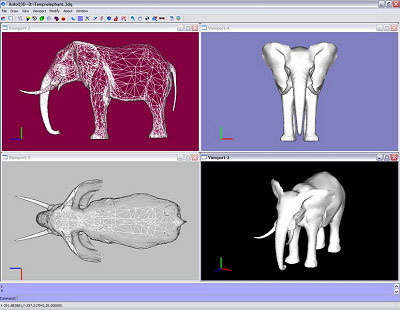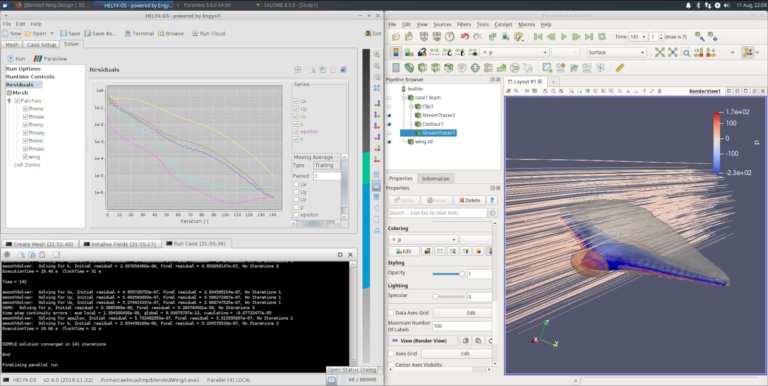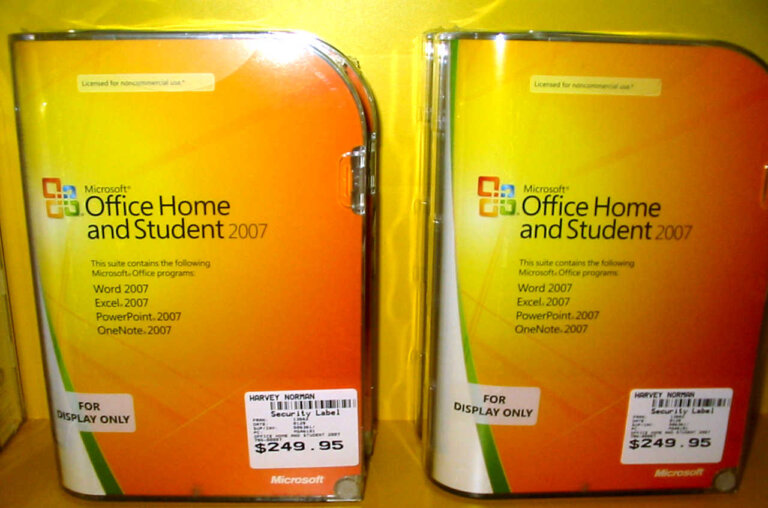We present you an extensive list with 25 (or almost 25) Free 3D modeling applications. They are software ranging from modeling, animation and rendering of objects in three dimensions. Here is the list:
CAD and 3D modeling applications
Blender

Blender is a free and open source software for the creation of 3D graphics, animations, visual effects, video games and virtual worlds. It was created in 1994 by Dutchmen Ton Roosendaal and Frank Steeman and is currently maintained and developed by the Blender Foundation, a non-profit organization based in the Netherlands.
Blender is used in a wide variety of fields, including film, advertising, video games, architecture, engineering and industrial design. Some of the film productions that have used Blender include the animated film “Sintel” and the short film “Tears of Steel”.
Advantages:
- It is a very powerful and versatile tool that allows you to create a wide variety of 3D content.
- It has a very active and supportive community that offers online resources and support.
- It is free and open source software, which means that it is free and its source code can be modified and distributed.
- It offers an intuitive and easy-to-use interface, especially for those who already have experience with other 3D modeling programs.
Disadvantages:
- It can have a steep learning curve for those who have no prior experience with 3D modeling software.
- Being such a powerful and versatile tool, it can be overwhelming for novice users.
- Being open source software, there may be a lack of official technical support compared to other commercial options.
License: GNU General Public License (GPL)
Website: https://www.blender.org/
FreeCAD
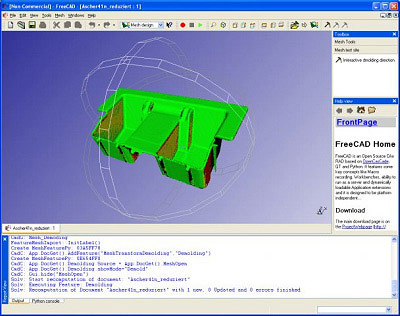
FreeCAD is an open source software for 3D solid and surface modeling, especially designed for mechanical engineering and product design. It started its development in 2002 and has evolved into a powerful and versatile tool with an active community of users and developers.
Advantages:
- It is free and open source software, which means that it is free and its source code can be modified and distributed.
- It offers a wide range of 3D modeling tools, including extrusion, revolution, sweep, and many more.
- It allows parametric work, which means that you can easily modify the parameters of a design at any time.
- It has an intuitive and easy-to-use user interface, with support for multiple languages.
- It can import and export files in a variety of formats, including STEP, IGES, DXF, SVG, STL, OBJ and others.
- It is compatible with macOS, Linux and Windows.
Disadvantages:
- Although its interface is intuitive, it can have a steep learning curve for those unfamiliar with 3D modeling.
- Unlike some other CAD programs, FreeCAD is not specifically designed for architectural or graphic design applications.
- Although the community of users and developers is active, it is not as large as some other commercial CAD programs, which can mean fewer learning resources and support available.
License: GNU General Public License (GPLv2 ).
Website: https://www.freecadweb.org/.
OpenSCAD
OpenSCAD is an open source program for creating 3D models. Unlike other 3D modeling tools, OpenSCAD relies on describing objects in a scripting syntax similar to a programming language. This means that users create models by writing code, rather than by directly manipulating objects in a graphical interface.
OpenSCAD was created in 2009 by Marius Kintel and Clifford Wolf as a tool for creating 3D models for 3D printing. Since then, it has become popular among 3D printing enthusiasts, designers and engineers due to its script-based approach and its ability to create complex geometries.
Advantages:
- OpenSCAD is a powerful and flexible tool for creating complex 3D models.
- The script-based interface allows users to easily create variations of a model by changing parameters in the code.
- OpenSCAD is open source and free.
- There is a large community of users and developers who contribute scripts and reusable libraries.
Disadvantages:
- The script-based interface can have a steep learning curve for users unfamiliar with programming.
- OpenSCAD is not an interactive 3D modeling tool and does not allow direct manipulation of objects in a 3D view.
- It is not suitable for rapid creation of simple or artistic 3D models.
License: GNU General Public License (GPL)
Website: https://www.openscad.org/
LibreCAD
LibreCAD is a free and open source computer-aided design (CAD) program. It was created in 2010 as a fork of the popular QCAD program, and has since evolved into a powerful and easy-to-use CAD design tool.
LibreCAD is designed primarily for 2D design, making it ideal for a variety of uses, such as architectural design, mechanical design, electrical design and civil engineering. Some of the advantages of using LibreCAD include its intuitive and easy-to-use user interface, its wide range of drawing and editing tools, and its ability to import and export files in a variety of formats, such as DXF, DWG and SVG.
However, LibreCAD also has some disadvantages. For example, it does not have 3D design capabilities, which may be a disadvantage for some users. Also, although LibreCAD is easy to use, it can have a steeper learning curve than some other simpler CAD programs.
License: GNU General Public License (GPL)
Website: https://librecad.org/
Slic3r
Slic3r is an open source software used to generate G-code from 3D modeling files. It was created in 2011 by Alessandro Ranellucci and has since become a popular tool in the 3D printing community. The program is designed to work with FFF (Fused Filament Fabrication) 3D printers and supports most 3D file formats, including STL and OBJ.
Slic3r is used to prepare 3D models for printing, dividing them into layers and generating the necessary instructions for the 3D printer to create the desired object. The program offers a wide range of configuration options, allowing users to customize print quality and print parameters to suit their needs.
Advantages:
- Slic3r is free and open source software, which means it is available for use and modification by anyone.
- It offers a wide range of configuration options, allowing users to customize print quality and print parameters according to their needs.
- It is compatible with most 3D file formats and most FFF 3D printers on the market.
- It has an intuitive and easy-to-use user interface.
Disadvantages:
- The wide range of configuration options can be overwhelming for novice users.
- Slicing process can be slow compared to other slicing programs.
- Not compatible with SLA or SLS 3D printers.
License: Artistic License 2.0
Website: https://slic3r.org/
TinkerCAD
TinkerCAD is a cloud-based computer-aided design (CAD) program created by Autodesk in 2011. It is designed primarily for beginners and educators, making it an ideal tool for teaching basic 3D design, programming and electronics concepts.
Uses:
- 3D Modeling: Creates 3D models for 3D printing or computer-aided design.
- Programming: Provides a coding platform to teach users how to program with code blocks.
- Electronics: Allows users to design and simulate electronic circuits.
Advantages:
- Easy to use: Intuitive and user-friendly interface, ideal for beginners.
- Cloud-based: No installation required and can be used on any device with internet connection.
- Wide range of tutorials and educational resources.
- Compatible with 3D printers and online 3D printing services.
Disadvantages:
- Limitations in advanced features: not suitable for more complex 3D design projects.
- Internet dependency: Requires a stable internet connection to use it.
License: TinkerCAD license is free.
Website: https://www.tinkercad.com/
SketchUp
SketchUp Free is a free version of the popular 3D modeling software SketchUp. SketchUp is an open source program that was originally developed by @Last Software and then acquired by Google in 2006. In 2012, Trimble acquired SketchUp from Google and has since offered different versions of the tool, including the free SketchUp Free version.
SketchUp Free is designed primarily for personal and educational use, and is suitable for a variety of uses, such as architectural design, interior design, urban planning, product design, and general 3D modeling.
Advantages:
- Free access to powerful and easy-to-use 3D modeling tools.
- Support for a wide range of file formats, including .skp, .dwg, .dxf and .dae.
- Access to an active online community and learning resources.
- Integration with Google Maps and Google Earth for modeling real locations.
Disadvantages:
- Advanced features and collaboration tools are limited to paid versions of SketchUp.
- No technical support is available for SketchUp Free users.
- Exporting models to specific file formats is restricted to the paid versions.
License: Creative Commons Attribution-NonCommercial-ShareAlike 3.0
Website: https://www.sketchup.com/es/free
Wings 3D
Wings 3D is a free and open source 3D modeling editor with an intuitive and easy-to-use interface. It was created in 2001 by Björn Gustavsson and Dan Gudmundsson, and has since been developed by a community of active users and developers.
Wings 3D is primarily used to create 3D models for games, animation and industrial design. Its focus on ease of use and the ability to customize the interface make it ideal for beginners and advanced users alike.
Advantages
- Wings 3D is a free and open source 3D modeling tool, which means it is available for use and modification at no cost.
- Wings 3D’s user interface is intuitive and easy to use, making it ideal for beginners and intermediate users.
- Wings 3D features a wide range of modeling tools and functions, including extrusion, scaling, rotation, deformation and more.
- The Wings 3D user and developer community is active and supportive, which means there are a wealth of resources and tutorials available online.
Disadvantages
- Wings 3D is not a professional 3D modeling tool and therefore may not be suitable for large or highly complex projects.
- Wings 3D does not have some of the advanced features found in other 3D modeling tools, such as fluid simulation or advanced animation.
- The user interface of Wings 3D may be a bit limited compared to other more modern and sophisticated 3D modeling tools.
License: GNU General Public License (GPL).
Website: https://www.wings3d.com/
MeshLab
MeshLab is an open source, cross-platform 3D mesh viewer and editor. It was created in 2005 by the Institute of Information Sciences and Technologies of the Italian National Research Council (ISTI-CNR) and has since been widely used in a variety of fields, such as research, education and industry.
The program is capable of reading and writing a wide variety of 3D file formats, including the most common ones such as OBJ, STL, PLY and 3DS. In addition to visualizing 3D models, MeshLab offers a wide range of tools for mesh editing and processing, such as hole repair, mesh simplification, duplicate triangle removal and texture application.
Advantages:
- It is open source and free.
- Multi-platform, available for Windows, Mac and Linux.
- Wide range of mesh editing and processing tools.
- Capable of reading and writing a wide variety of 3D file formats.
Disadvantages:
- User interface can be a bit confusing for novice users.
- Not suitable for editing highly detailed or large 3D models.
License: GNU General Public License (GPL) version 3.
Website: https://www.meshlab.net/.
LeoCAD
LeoCAD is an open source program for creating 3D models using virtual LEGO bricks. It was created in 2003 by Leonardo Zide and has been under development ever since. The program is used both for designing LEGO models and for creating 3D artwork and animations.
LeoCAD features an easy-to-use interface and a large number of virtual LEGO pieces available for use. It also allows users to import and export models in different formats, such as LDraw and LDD.
Advantages:
- Easy to use interface
- Large number of available virtual LEGO pieces
- Import and export of models in different formats
- Active community of users and developers
Disadvantages:
- Not official and not supported by The LEGO Group
- May be less intuitive for novice users compared to other 3D modeling programs
License: LeoCAD is licensed under GNU General Public License (GPL)
Website: https://www.leocad.org/
BRL-CAD

BRL-CAD is an open source, cross-platform computer modeling and rendering system that has been in active development since 1984. It was originally developed for weapons analysis applications and is now used in a variety of fields, such as engineering, architecture and education.
BRL-CAD is known for its powerful constructive solid geometry (CSG) engine, which allows users to create complex models by combining simple geometric shapes. It also includes rendering and animation tools, as well as a wide range of data processing and format conversion utilities.
Advantages:
- BRL-CAD is a free and open source system, which means that it is available for unrestricted use and modification.
- It is highly customizable and can be extended with third-party modules and add-ons.
- Its CSG engine is powerful and efficient, making it suitable for the creation of complex models.
- It includes a wide range of tools and utilities, making it suitable for a variety of applications.
Disadvantages:
- BRL-CAD’s user interface can be difficult to learn for users with no previous CAD experience.
- It is not as popular as other commercial CAD systems, which can make it difficult to obtain support and learning resources.
- Some of its tools and utilities may be outdated and not up to par with more modern offerings.
License: GNU General Public License (GPL)
Website: https://brlcad.org/
PyMOL
PyMOL is an open source molecular modeling and visualization tool, widely used in the field of bioinformatics and materials science. It was created in 1997 by Warren Lyford DeLano and has since evolved into one of the most popular tools for visualization and analysis of three-dimensional molecular structures.
PyMOL is used in a variety of applications, including the visualization of proteins, nucleic acids, lipids and carbohydrates, as well as the representation of molecular interactions and the creation of images and animations for presentations and publications.
Advantages:
- Intuitive and easy-to-use user interface.
- Wide range of functionalities for visualization and analysis of molecular structures.
- Ability to handle large data sets and a variety of file formats.
- Active community of users and developers who contribute plugins and scripts to extend PyMOL’s capabilities.
Disadvantages:
- The free version of PyMOL has limitations in terms of available functionality and the ability to save files in specific formats.
- The learning curve can be steep for users with no previous experience in molecular visualization.
- Some of the more advanced features require programming and scripting skills.
License: PyMOL Open Source.
Website: https://pymol.org/.
Sculptris
Sculptris is a digital sculpting program created by Pixologic, the same company that developed the popular ZBrush software. It was released in 2009 with the goal of providing an intuitive and easy-to-use sculpting tool for beginner and enthusiast 3D artists. Unlike other 3D modeling programs, Sculptris focuses on digital sculpting, allowing users to create complex and detailed shapes with relative ease.
Sculptris’ user interface is simple and minimalistic, allowing users to focus on their artwork rather than being distracted by complex options and settings. The program uses a voxel grid instead of traditional polygons, making it easy to create smooth, organic shapes. In addition, Sculptris includes advanced modeling and painting tools, such as Symmetrize, Move, Smooth, and Inflate, which allow users to create complex details and textures on their models.
Advantages:
- Simple and easy-to-use user interface.
- Intuitive and powerful sculpting tools.
- Voxel grid that facilitates the creation of organic shapes.
- Advanced modeling and painting tools.
- Free and accessible for beginner 3D artists.
Disadvantages:
- Not suitable for large scale or high resolution projects.
- No advanced rendering and animation features.
- It is not compatible with third-party plugins.
- Has not been updated since 2011, which means it is not compatible with newer operating systems.
License: Free
Website: https://www.pixologic.com/sculptris/
Art of Illusion
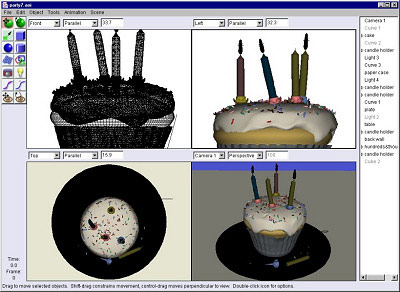
Art of Illusion is an open source, cross-platform 3D modeling and rendering application. It was created in 2000 by Peter Eastman as an open source alternative to commercial 3D modeling software. Art of Illusion is used in a variety of applications, including art creation, industrial design, animation and games.
Art of Illusion’s user interface is intuitive and easy to use, making it suitable for beginners and professionals alike. The program features a wide range of tools and functions, including modeling, texturing, lighting, animation and rendering.
Advantages:
- Art of Illusion is a free and open source application.
- It has an intuitive and easy-to-use user interface.
- It offers a wide range of tools and functions for modeling, texturing, lighting, animation and rendering.
- It is cross-platform and is available for Windows, Mac and Linux.
Disadvantages:
- Art of Illusion is not as powerful as some commercial 3D modeling programs.
- The user community and technical support are not as large as in other 3D modeling programs.
License: GNU General Public License (GPL).
Website: https://www.artofillusion.org/.
SculptGL
SculptGL is a real-time digital sculpting and 3D modeling web application created in 2014 by French developer Stephane Ginier. It offers an intuitive interface and a wide range of tools and functionalities that allow users to create and edit complex 3D models directly in their browser, without the need to install any additional software.
The application is used by artists, designers, students and 3D enthusiasts to create a variety of models, from human figures and animals to abstract objects and complex scenes. SculptGL has a large community of users who share their creations and provide support and advice on the application’s official forum.
Advantages:
- Accessible and easy to use, requiring only a compatible web browser.
- Offers a wide range of 3D modeling and sculpting tools and functionalities.
- Allows importing and exporting models in common formats, such as OBJ, STL and PLY.
- It has an active community of users who share their creations and provide support.
Disadvantages:
- It is not a desktop application and therefore may be less powerful and less capable than other desktop 3D sculpting and modeling applications.
- May be slower and less responsive on lower spec devices.
License: MIT License
Website: https://sculptgl.com/
Houdini Apprentice
Houdini Apprentice is a free, limited version of the Houdini animation and visual effects software, developed by SideFX. This version is designed specifically for artists and students who wish to learn and experiment with the software without having to pay a full license fee.
Houdini Apprentice offers all the functionality of Houdini Indie, but with some restrictions on output file size and animation duration. In addition, projects created with Houdini Apprentice cannot be used for commercial purposes.
Houdini Apprentice’s user interface is intuitive and easy to use, making it suitable for beginners and advanced users alike. The software features a wide range of tools and functionalities for creating visual effects, 3D animations and physics simulations.
Advantages:
- Free access to a limited version of Houdini Indie.
- Ideal for learning and experimenting with the software.
- Offers all the functionality of Houdini Indie, except for the restrictions mentioned above.
- Intuitive and easy to use user interface.
- Wide range of tools and functionalities for creating visual effects, 3D animations and physics simulations.
Disadvantages:
- Restrictions on output file size and animation duration may be limiting for some users.
- Projects created with Houdini Apprentice cannot be used for commercial purposes.
License: Houdini Apprentice
Website: https://www.sidefx.com/products/houdini-apprentice/
ZBrushCoreMini
ZBrushCoreMini is a simplified, free-to-access version of the popular ZBrush digital sculpting software, developed by Pixologic. ZBrushCoreMini is designed to be an introductory 3D sculpting tool aimed at beginners, educators and digital art enthusiasts.
It offers a simple user interface and basic tools for creating 3D modeling, texturing and painting, allowing users to enter the world of 3D content creation without prior knowledge. ZBrushCoreMini supports export to standard 3D file formats such as OBJ and STL, making it easy to 3D print or exchange with other 3D modeling programs.
Advantages:
- Free access to a simplified version of ZBrush.
- Simple and easy-to-use user interface.
- Basic tools for 3D modeling, texturing and painting.
- Support for export to standard 3D file formats.
Disadvantages:
- Limited functionality compared to full ZBrush.
- Not suitable for high-end or professional projects.
- Does not include advanced features such as dynamesh, ZRemesher or ZBrush BPR.
License: Free.
Website: https://www.pixologic.com/zbrushcore/mini
MakeHuman
MakeHuman is an open source application used for the creation of realistic 3D models of humans. The project began in 2001 and has since evolved to offer a wide range of customization and personalization options. MakeHuman is used in a variety of fields, including animation, video games, illustration and industrial design.
Advantages:
- Offers an intuitive and easy-to-use user interface.
- Allows a large number of options for customization and personalization of 3D models.
- It has an active community and a large amount of online resources.
- It is a free and open source tool.
Disadvantages:
- It can have a learning curve for those unfamiliar with creating 3D models.
- It is not a professional modeling tool and may not be suitable for large-scale projects.
License: General Public License (GPL)
Website: https://www.makehumancommunity.org/
K-3D
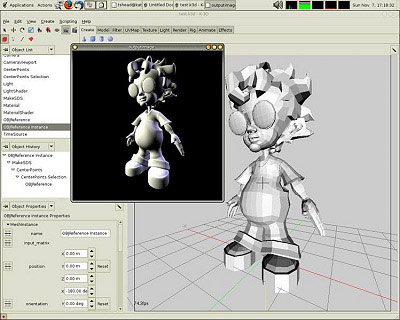
K-3D is an open source, cross-platform 3D modeling and animation software. It was started in 2001 by Kevin Kwok and is currently maintained by a community of developers. K-3D is used in a variety of applications, including architecture, engineering, industrial design, motion graphics and visual effects.
Advantages:
- K-3D is free and open source software, which means it is available for use and modification at no cost.
- It is cross-platform, which means it can be used on different operating systems, including Windows, Mac OS X and Linux.
- K-3D has an intuitive and easy-to-use user interface, making it suitable for both beginners and advanced users.
- The software supports a wide range of file formats, including the most common file formats used in the 3D animation industry.
- K-3D has a modular architecture, allowing users to easily add and remove functionality as needed.
Disadvantages:
- K-3D is not as popular as other 3D animation software, which means there is a smaller user community and fewer online resources available.
- The software is not as powerful as some of its commercial competitors, which can limit its usefulness on larger, more complex projects.
- K-3D can be slow and require a lot of system resources compared to other 3D animation programs.
License: GNU General Public License (GPL).
Web site: https://k-3d.org/
Aqsis
Aqsis is a rendering engine that implements Pixar’s RenderMan specification. This means that Aqsis can render high quality, photorealistic realistic images, just like the rendering engines used in the animation and visual effects industry. Aqsis is used by artists and animation studios worldwide to create high quality images and animations.
Advantages:
- Aqsis is open source software and is freely available.
- It implements Pixar’s RenderMan specification, which means it can render high-quality, photorealistic images.
- It supports a variety of file formats, including OBJ, FBX, and Alembic.
- It has an active community of users and developers who offer online support and resources.
Disadvantages:
- Aqsis can be difficult to use for those unfamiliar with rendering engines and the RenderMan specification.
- It is not as fast as some commercial rendering engines, which can be a problem for large-scale projects.
- It does not have the same amount of features and tools as some commercial rendering engines.
License: GNU General Public License (GPL)
Website: https://aqsis.org/
Seamless3D

Seamless3D is a free and open source 3D modeling software, designed specifically for the creation of content for 3D animation and games. It was created in 2002 by Loic Duestremez, a French software developer, and has since been maintained and improved by a small community of 3D animation enthusiasts.
The software is notable for its focus on creating seamless 3D models, which means that models created with Seamless3D can be rendered without showing the seams or joints between different parts of the model. This feature is particularly useful in the creation of characters and objects for 3D games and animations.
Advantages:
- Seamless3D is free and open source 3D modeling software, which means that it is accessible to everyone and can be freely modified and distributed.
- The software is specifically designed for the creation of seamless 3D models, making it ideal for creating characters and objects for 3D games and animations.
- Seamless3D features an intuitive and easy-to-use user interface, making it suitable for beginners and advanced users alike.
- The software supports a wide variety of file formats, including OBJ, 3DS, and COLLADA, making it compatible with a wide variety of 3D animation and gaming software.
Disadvantages:
- Seamless3D is not as well known as other 3D modeling software, which can make it difficult to find online resources and tutorials.
- The software does not have all the advanced features and tools offered by other commercial 3D modeling software, such as Maya or 3DS Max.
License: MIT License
Website: https://seamless3d.com/
Clara.io
Clara.io is a free online 3D modeling and animation application created by Exocortex, a company specializing in the development of 3D graphics technology. It was launched in 2013 and has since gained popularity among designers, artists and 3D animation enthusiasts. Clara.io allows you to create, edit and share 3D models and animations directly from a web browser, without the need to install additional software.
Clara.io is a versatile tool that can be used in a variety of fields, such as product design, architecture, film and video games.
Advantages:
- Accessibility: Clara.io is available online and is compatible with most modern web browsers, allowing users to access their projects from any location and device.
- Functionality: Clara.io offers a wide range of tools and functions for 3D modeling and animation, including extrusion, lathe, sweeping, Boolean, rigging and skinning.
- Collaboration: Clara.io allows users to collaborate in real time on 3D projects, facilitating teamwork and project review.
- Compatibility: Clara.io supports import and export of models and animations in a variety of popular formats, making it easy to integrate with other tools and platforms.
Disadvantages:
- Performance: Clara.io is a web-based application, which means that its performance may be affected by the speed and stability of the user’s internet connection.
- Storage limitations: Clara.io offers a limited amount of free storage, which can be a drawback for users working on large or complex projects.
- Complexity: Clara.io has a relatively steep learning curve, which can be a challenge for novice users.
License: Clara.io uses a proprietary license and offers different subscription levels, including a free option with limited features.
Website: https://clara.io/
3D-Coat
3D-Coat is a 3D modeling, texturing and 3D painting software developed by the Ukrainian company Pilgway. It was first released in 2007 and has since become a popular tool among 3D artists and designers. 3D-Coat is mainly used for the creation of high-quality modeling, texturing and painting of 3D characters and 3D environments. It is also known for its powerful retopology tool, which allows users to create low poly meshes with ease.
Advantages:
- Powerful modeling and retopology tool that allows users to create high quality modeling and low poly meshes.
- Advanced texturing and painting tools that allow users to create high quality textures and maps.
- Intuitive and easy-to-use user interface.
- Compatible with a variety of file formats and 3D modeling software.
- Large user community and online resources available.
Disadvantages:
- Limited free version.
- Learning curve can be steep for novice users.
- Not as well known as other 3D modeling software, which can make it difficult to find online resources and tutorials.
License: Pilgway
Website: https://www.3d-coat.com/
Community Mode
Modo Community is a powerful 3D modeling and rendering software that offers a wide range of tools and functionality for 3D content creation. The program is used in a variety of industries, including product design, architecture, film and games. Modo Community is known for its intuitive interface and focus on the artist’s workflow, making it suitable for artists and designers of all experience levels.
Advantages:
- Modo Community is a free, open source version of Modo software, which means it is available for use and modification at no cost.
- The program offers a wide range of tools and functionality for 3D content creation, including modeling, texturing, lighting and rendering.
- Modo Community has an intuitive interface and a focus on artist workflow, making it easy to use for artists and designers of all experience levels.
- The software supports a variety of file formats, making it easy to integrate with other programs and production pipelines.
Disadvantages:
- As open source software, Modo Community does not have the same level of support and technical assistance as its commercial counterpart.
- Some advanced features and tools are limited or not available in Modo Community.
- The program can be demanding in terms of system resources, especially when using advanced rendering techniques.
License: Modo Community is distributed under an open source license.
Website: https://www.foundry.com/.
